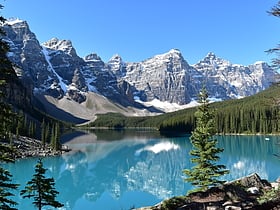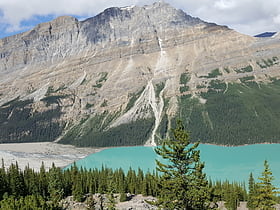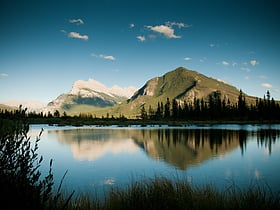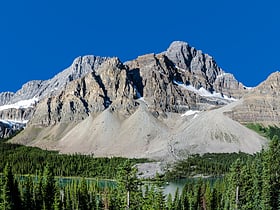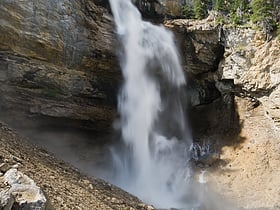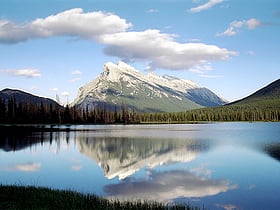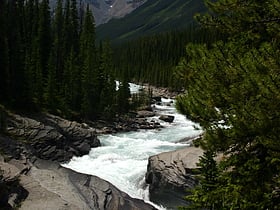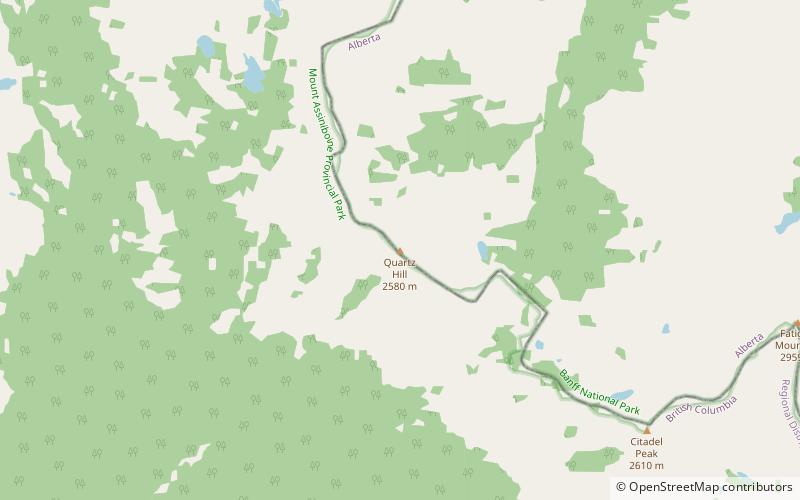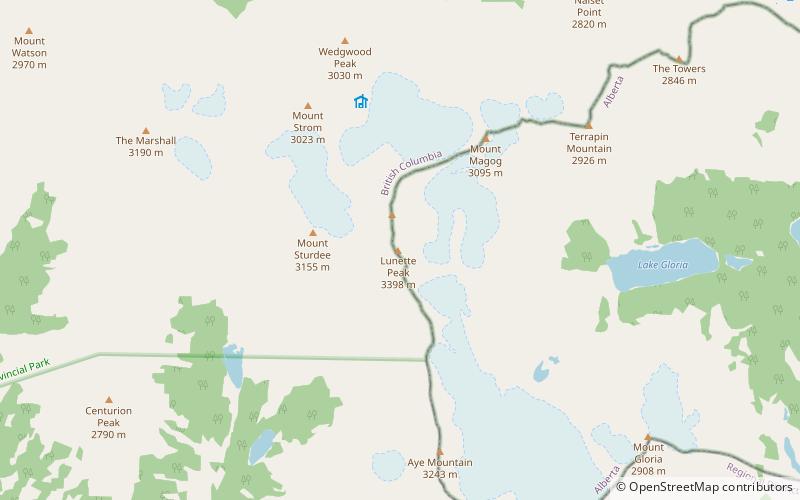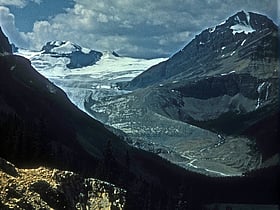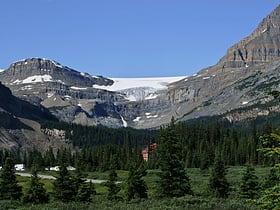Banff National Park: Nature
Places and attractions in the Nature category
Moraine Lake
Glacier-fed lake with a canoe dock Nestled in the heart of the majestic Canadian Rockies, Moraine Lake is a true jewel of Banff National Park in Alberta, Canada. Known for its strikingly vibrant turquoise waters, the lake is surrounded by a breathtaking panorama of towering mountains and lush forest...
Peyto Lake
Nestled in the heart of Banff National Park, Peyto Lake is a stunning glacial-fed body of water renowned for its vibrant turquoise hue. This remarkable lake, located in the province of Alberta, Canada, offers visitors a chance to witness the breathtaking beauty of the...
Vermilion Lakes
3 lakes with wildlife and a bike trail The Vermilion Lakes are a series of lakes located immediately west of Banff, Alberta, in the Canadian Rocky Mountains. The three lakes are formed in the Bow River valley, in the Banff National Park, at the foot of Mount Norquay.
Bow Lake
Glacial lake with a historic lodge Bow Lake is a small lake in western Alberta, Canada. It is located on the Bow River, in the Canadian Rockies, at an altitude of 1920 m.
Panther Falls
Panther Falls are a series of waterfalls in Banff National Park, Alberta, Canada. It is developed on Nigel Creek and its waters originate in Nigel Pass, between the slopes of Cirrus Mountain and Nigel Peak in the Parker Ridge of the Canadian Rockies.
Bow Glacier Falls
Bow Glacier Falls is located near Banff, AB. The falls originates from melt water from the Bow Glacier and flows into Bow Lake.
Mount Rundle
Mount Rundle is a mountain in Canada's Banff National Park overlooking the towns of Banff and Canmore, Alberta. The Cree name was Waskahigan Watchi or house mountain.
Hector Lake
Glacial lake with mountain views Hector Lake is a small glacial lake in western Alberta, Canada. It is located on the Bow River, in the Waputik Range of the Canadian Rockies. It is named after James Hector, a geologist and naturalist with the Palliser Expedition.
Mount Temple
Mount Temple is a mountain in Banff National Park of the Canadian Rockies of Alberta, Canada. Mt. Temple is located in the Bow River Valley between Paradise Creek and Moraine Creek and is the highest peak in the Lake Louise area.
Mount Assiniboine
Mount Assiniboine, also known as Assiniboine Mountain, is a pyramidal peak mountain located on the Great Divide, on the British Columbia/Alberta border in Canada.
Cirque Peak
Cirque Peak is a 2,993-metre peak located directly west of Dolomite Pass in the Bow River valley of Banff National Park, in the Canadian Rockies of Alberta, Canada. The mountain forms a cirque, hence the name.
Mistaya Canyon
Mistaya Canyon is a canyon in the western part of the Canadian province of Alberta. It is formed by the Mistaya River. Tourists who are visiting Banff National Park often visit it because of its distinctive curvy canyon walls and because it is easy to access, being just off the Icefields Parkway.
Whitehorn Mountain
Whitehorn Mountain is located in the Slate Range of Banff National Park in Alberta, Canada.
Cascade Mountain
Cascade Mountain is a mountain located in the Bow River Valley of Banff National Park, adjacent to the town of Banff. The mountain was named in 1858 by James Hector after the waterfall or cascade on the southern flanks of the peak.
Mount Chephren
Mount Chephren is a mountain located in the Mistaya River Valley of Banff National Park, Canada. Mount Chephren was named after Chephren, the 4th Dynasty Egyptian pharaoh. The mountain was originally named Pyramid Mountain in 1897 by J.
Lake Minnewanka
Lake Minnewanka is a glacial lake located in the eastern area of Banff National Park in Canada, about five kilometres northeast of the Banff townsite.
Mount Niblock
Mount Niblock is a mountain in Banff National Park near Lake Louise, Alberta, Canada. The mountain was named in 1904 after John Niblock, a superintendent with the Canadian Pacific Railway.
Observation Peak
Observation Peak is a 3,174-metre mountain summit located in Banff National Park, Alberta, Canada. The mountain can be seen from the Icefields Parkway near the Bow Summit. The peak was named in 1898 by Charles L.
Quadra Mountain
Quadra Mountain is located on the border of Alberta and British Columbia on the Continental Divide. It was named in 1910 by Arthur Oliver Wheeler. The name refers to the mountain's four pinnacles.
Mount Bowlen
Mount Bowlen is located on the border of Alberta and British Columbia and forms part of the Valley of the Ten Peaks. It was named in 1953 after John J.
Stoney Squaw Mountain
Stoney Squaw Mountain, often called just Stoney Squaw, is a mountain in the Bow River Valley of Banff National Park, adjacent to the town of Banff, Alberta, Canada.
Mount Louis
Mount Louis is a 2,682-metre mountain summit located in southeast Banff National Park in Alberta, Canada. It is part of the Sawback Range which is a subset of the Canadian Rockies. The mountain was named in 1886 after Louis B.
Mount Inglismaldie
Mount Inglismaldie is the second highest peak of the Fairholme Range in Banff National Park. It is located immediately west of Mount Girouard in the Bow River valley south of Lake Minnewanka. The mountain was named in 1886 by park superintendent George A. Stewart after Inglismaldie Castle in Kincardineshire, Scotland.
Fossil Mountain
Fossil Mountain is a mountain located south of Skoki Mountain in Banff National Park, Canada. The mountain was named in 1906 by M.P. Bridgland, of the first ascent party, after the numerous fossils that can be found on its slopes. Fossil Mountain is the site of the first known skiing fatality in the Canadian Rockies.
Quartz Hill
Quartz Hill is located on the border of Alberta and British Columbia on the Continental Divide. It is named due to the top of the mountain is mostly quartz.
Weeping Wall
The Weeping Wall is a set of cliffs, approximately 1000 feet high, located at the western base of Cirrus Mountain alongside Highway 93 in northern Banff National Park in Alberta, Canada, just south of the boundary with Jasper National Park.
Lunette Peak
Lunette Peak is located on the border of Alberta and British Columbia on the SE side of Mount Assiniboine along the Continental Divide. It was named in 1913 by the Interprovincial Boundary Survey.
Snow Dome
Snow Dome is a mountain located on the Continental Divide in the Columbia Icefield, where the boundary of Banff National Park and Jasper National Park meets the border of Alberta and British Columbia in Canada. The summit's elevation is 3,456 m. The mountain was named in 1898 by J.
Ptarmigan Peak
Ptarmigan Peak is a peak located beside Pika Peak in Banff National Park, Alberta, Canada. The mountain was named in 1909 by J.W.A. Hickson after he found several ptarmigan in the meadows below the peak. Hickson also made the first ascent guided by Edward Feuz jr.
East End of Rundle
East End of Rundle is a mountain located immediately west of the town of Canmore, Alberta and immediately west of the Spray Lakes road in the Canadian Rockies.
Mount Olive
Mount Olive is located on the Continental Divide, on the Alberta-British Columbia border, in both Banff National Park and Yoho National Park. It lies on the eastern edge of the Wapta Icefield, and is part of the Waputik Mountains. It was named in 1898 by H.B. Dixon after his wife Dixon, Olive.
Hidden Lake
Hidden Lake is a small glacial lake in the Skoki Valley of Banff National Park, Canada. It is located in the Slate Range of the Canadian Rockies.
Mount Brett
Mount Brett is a 2,984-metre summit located in the Massive Range of Alberta, Canada It is situated in Banff National Park, 20 kilometres west of Banff townsite, in the Canadian Rockies. Its nearest higher peak is Mount Ball, 12.52 km to the west.
Peyto Glacier
The Peyto Glacier is situated in the Canadian Rockies in Banff National Park, Alberta, Canada, approximately 90 km northwest of the town of Banff, and can be accessed from the Icefields Parkway.
Bow Glacier
Bow Glacier is located in Banff National Park, Alberta, Canada, approximately 37 km northwest of Lake Louise. It can be viewed from the Icefields Parkway.
Bourgeau Lake
Bourgeau Lake is a rock-rimmed alpine lake at the foot of Mount Bourgeau near Banff, in Banff National Park, Alberta. It is a popular hiking destination.
Mount Whyte
Towering peak with rugged trekking paths Mount Whyte is a mountain in Alberta, Canada located in Banff National Park, near Lake Louise. The mountain can be seen from the Trans-Canada Highway, and offers views of the Valley of the Ten Peaks, including the Chateau Lake Louise.
Crowfoot Mountain
Crowfoot Mountain is a mountain within Banff National Park in Alberta, Canada. The Crowfoot Glacier sits on the northeastern flank of the mountain. The mountain was named in 1959 after the glacier.
Bow Range
The Bow Range is a mountain range of the Canadian Rockies in Alberta and British Columbia, Canada. The range is named in associated with the Bow River and was officially adopted on March 31, 1917 by the Geographic Board of Canada.
Redoubt Mountain
Redoubt Mountain is a mountain located in Banff National Park, in the Canadian Rockies of Alberta, Canada. It forms the southern buttress of Boulder Pass. The mountain was named in 1908 by Arthur O. Wheeler, founding member of the Alpine Club of Canada, as it resembled a redoubt.
Mount Richardson
Mount Richardson is the highest mountain of the Slate Range located beside Pika Peak in Banff National Park, Alberta, Canada. The mountain was named in 1859 by James Hector after Sir John Richardson who was the ship's surgeon and naturalist on John Franklin's 1819 and 1825 expeditions into the Arctic.
Howse Peak
Howse Peak is the highest mountain in the Waputik Mountains, a subrange of the Canadian Rockies. It is located 5 km west of the Icefields Parkway, above Chephren Lake, on the continental divide between Alberta and British Columbia.
Peyto Peak
Peyto Peak is a mountain in the Waputik Range, part of the Canadian Rockies in Alberta, Canada. It lies at the north end of the Wapta Icefield, in Banff National Park, about one km east of the border with British Columbia and 32 km north of the town of Field.
Pilot Mountain
Pilot Mountain is a mountain in the Bow River valley of Banff National Park in Alberta, Canada. It is located southeast of Redearth Creek and directly west of the Trans-Canada Highway. The mountain was named in 1884 by George M.
Mount Cory
Mount Cory is a mountain located in the Bow River Valley in southeast Banff National Park, just north of Banff, Alberta, Canada. The mountain was named in 1923 after William Wallace Cory, deputy minister of the Interior from 1905 to 1930.
Map

